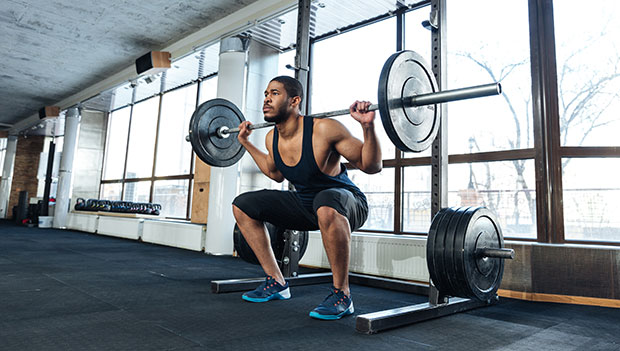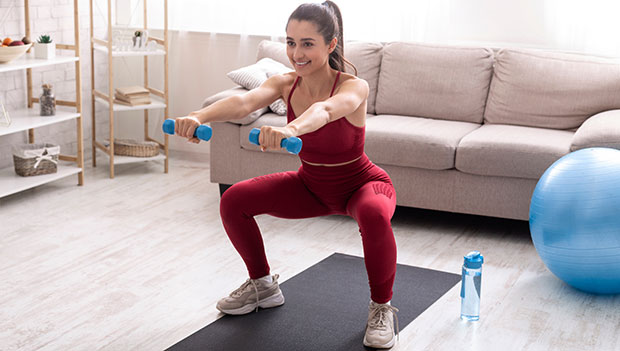
How to Build Muscle | Muscle-Building Nutrition | Muscle-Building Supplements | Hypertrophy Training | Strength Training | Chest Workouts | Back Workouts | Arm Workouts | Shoulder Workouts | Leg Workouts
Our legs make up about half of our body. So if you want to develop a complete, athletic physique, you must be dedicated to training your legs.
Like your back, your legs are made up of a series of larger muscles. Knowing how to distinguish between each of these—and knowing how to target your quads versus your hamstrings—can help you develop your leg muscles.
Training legs can seem overwhelming, but it doesn’t have to be. In this guide, we break down the top leg workouts to build muscle. We cover major muscles in the lower body, offer the best exercises for each, and discuss how to build a leg workout from scratch, including sets, reps, and more.
Short on equipment? No worries. We cover various exercises that use a variety of training tools, including barbells, dumbbells, machines, and bands.
What Muscles Make Up the Legs?
It would take a book to cover all of the muscles in the lower body so we’re just going to touch on the main ones for muscle-building. Below is a description of each as well as some of their important functions that allow us to move and exercise.
Glutes
The glutes are the largest muscle group in the body. They are responsible for the stability of the pelvis and the upper body. They also aid in movement and extension of the hip. Every major movement of the thigh muscle is assisted in some form by the glutes. Hip thrusts and squats are some of the best compound exercises for targeting the glutes.
Hamstrings
The hamstrings are located in the back of the thigh as part of the lower portion of the posterior chain, which is involved in pulling motions. They’re responsible for bending the knee and they also help with hinging the hips (a crucial movement for deadlifts). One of the best exercises for the hamstrings is a seated or lying leg curl.
Quadriceps
The quadriceps are a group of four muscles on the front of the thigh that are responsible for pushing as well as running, walking, and jumping. They also help straighten the leg—if you have to push something away from you using your feet, the quads bear the majority of the load. Squats of any kind are great for developing your quads, as well as accessory exercises like a leg extension movement.
Abductors/Adductors
The adductors are located on the inside of the thighs, and they pull the thighs together at the hip joint. They’re also used when the thigh has to be laterally rotated.
Conversely, the abductors are on the outside of the thighs, and they stabilize the thigh while you're walking or running. They work when you pull your thigh away from the body's midline. Movements like a wide-stance sumo squat or deadlift, or a hip abduction machine, target these muscles.
Calves
The calves are located below the knee, and their most important functions are to stabilize the leg when standing and engage the foot when you're walking. When you rise up on your toes, the calves are flexed. They also work when you rotate your ankles and plant your feet onto the floor or ground.
Best Leg Exercises
While there are some core movements that are best for building your leg muscles, we understand everyone may not have access to a health club or commercial gym. So, the descriptions that follow include the basic versions as well as alternatives for those that may be using other equipment.
Squat

The squat is the preeminent leg workout for all of your quad muscles as well as your glutes. We recommend performing this movement in a squat rack with the safety arms high enough to hold the barbell should you fail. If you don't have a squat rack, use dumbbells or your own bodyweight instead.
Set a barbell in a rack at shoulder height. Step under the barbell and position it in the middle-back of your shoulders. Grip the barbell with both hands to maximize stability. Stand up with the barbell and take two or three steps back. You should position your feet so they are slightly wider than shoulder-width apart and even. Your toes can be pointed straight or slightly outward (if you want to emphasize more of your glutes, we recommend standing with a slightly wide stance with feet pointed outwards).
Keep your core tight as you lower your hips and squat down until the tops of your thighs are parallel with the floor. Your back should be in a neutral position as you should look straight ahead. Once you go as deep as you can, drive through your heels and return to the standing position you started with. Repeat for the desired reps.
If you're using a dumbbell, hold a dumbbell in each hand. You can either hold the dumbbells down at your side or prop them up so that they rest on your shoulders. Then, perform the same squatting movement that you would with the barbell on your back. If you’re squatting deep enough, you may be able to touch the floor with the dumbbells at the bottom of the movement. If not, it's okay.
If you’d like to challenge yourself beyond your body weight, try using a band. Stand in the middle of the band and hold an end in each hand. Lift your hands up to shoulder height as if you were holding a barbell. Perform the squatting motion as you would with a barbell. The band should lose tension as you squat down, and it should increase in tension as you squat back up.
A few tips: If you’re new to weight lifting, we recommend performing squats with just the barbell before adding any weight. This helps you become familiar with the exercise. Once you feel like you have your squat stance and position down, then you can challenge yourself by adding weight. Also, we’ve found it helpful to perform exercises like this in front of a mirror. This allows you to check your form as you’re performing the movement and adjust as needed.
Romanian Deadlift
This exercise is one of the most effective when it comes to targeting both the glutes and the hamstrings. The key to the movement is performing it slowly and carefully. Jerking the weight in this position can lead to injury.
Stand behind a barbell that’s positioned on the floor. Grab the weight with an overhand grip that’s wider than shoulder-width apart. Your feet should be shoulder-width with toes pointed out. Keep your back straight and core tight, making sure to hinge at the hips, as you lower yourself down to grab the bar.
Bend your knees slightly (make sure not to lock your knees out) before starting your descent. Your knees should maintain this slight bend throughout the exercise. Hinge the hips and push your glutes back as if you were trying to touch the wall behind you. Lower the bar until it reaches the middle of your shins. Contract your glutes and push your hips forward. While doing this, the bar should start coming back up until you're at the starting position again. Repeat for the desired reps.
If you have dumbbells, perform this exercise with a dumbbell in each hand while holding them at the front of the thighs. To increase the range of motion, allow the dumbbells to drift to your sides as you bend forward.
Leg Press

This is the most popular leg machine because it allows you to move heavier weight in a safe manner without compromising the lower back. There are many different versions of the leg press, but generally, the instructions that follow will help you.
Sit on the seat and position your feet on the footplate so they are shoulder-width apart or slightly wider. Your toes should be pointed straight or slightly out. When you're ready to begin, push the footplate up and release the handles. The entire weight of the sled should be on your legs. Bend your knees and control the descent of the sled until your knees are close to your chest. Once you're lowered the sled as slowly as you can, push through your feet and press the sled back up until your legs are straight. Be careful to not lock out your knees. Repeat for the desired reps.
If you're using a band, lie on the floor with the ends of the band in each hand. Lift your feet up as if you're trying to press weight up. Place the middle of the band across the bottom of your feet. Keep the ends in your hands and down to your sides. Slowly straighten your legs, which should cause the band to increase in tension. Once your legs are straight, slowly return to the starting position. If you can't keep your hands down while straightening the legs, then you need to use a lighter band with less resistance.
Leg Curl
The leg curl isolates the hamstrings because the knee is bending while you're fighting resistance. No other body part should be involved in this exercise. It can be performed with a machine, or with a dumbbell or ankle weights.
Lie on the leg curl machine, and position yourself as the instructions on the machine suggest. Your feet should be under the pad that is moving while your knees are stable. Bend your knees and lift the pad in order to contract the hamstrings. Lift the pad as high as you can. Slowly lower the pad and return to the starting position. Repeat for the desired reps.
If you have a dumbbell, then you can do this exercise as well. Lie on the floor stomach down with a dumbbell positioned between your feet. Squeeze your feet together as tight as you can to keep the weight in place. Bend the knees and lift the dumbbell up until it reaches your glutes. Slowly lower to the starting position and repeat for the desired reps. If you have ankle weights, place those on your ankles and perform the exercise in the same fashion.
Leg Extension
This exercise has received some negative attention because of the possibility of knee injuries. But as long as your knees are healthy and you perform the movement properly, it can be a great way to isolate the quadriceps.
Sit on a machine with your feet under the pad. Make sure your back and butt are secured in the seat. Lift the pad by straightening the legs. When you reach the top of the movement, the quads should be flexed. Slowly allow the pad to lower by bending the knees and returning to the starting position. Repeat for the desired reps.
If you have a dumbbell, sit on a bench or chair with a dumbbell between your feet. Squeeze the feet together as hard as you can so the dumbbell doesn't move. Straighten the legs and lift the dumbbell up to contract the quads. Slowly bend the knees and lower the dumbbell to the starting position and repeat.
Seated Calf Raise
The seated calf machine focuses more on the soleus, which is the portion of the calf muscle that works when the knees are bent. You can do this movement on a machine, but the dumbbell version may be even more effective.
Place a board or step in front of a chair. Sit on the chair with your feet on the step, heels off. Place a dumbbell vertically on each thigh and keep them there with your hands. Rise up on your toes and flex the calves. Your knees and the dumbbells should go up as well. Slowly lower your heels until you feel a stretch in the lower portion of your leg. Repeat for the desired reps. If you have a barbell with plates, you can do this same exercise while holding the bar on your thighs above the knee area.
Standing Calf Raise
This exercise challenges the gastrocnemius, which is the portion of the calf that activates when you stand on your toes with the legs straight. There is also a specific machine for this, but the barbell version can be very beneficial as well.
Place a board in front of the area where you’ll be lifting the barbell. Position the barbell as you would for a squat. Doing this inside a rack would be best. Place the feet on the board so the heels are still on the floor. They should be shoulder-width apart. Once you feel stable, rise up on your toes and squeeze the calves. Slowly return to the starting position and repeat for the desired reps.
You can also do this calf workout with dumbbells. The best way is to hold one dumbbell while working the calf on the same side. Hold onto a solid object with the non-working side and lift the non-working leg so the working leg is isolated. Once you finish with the first leg, switch and repeat with the other.
Best Leg Workout
Looking for the ultimate leg workout? This section is for you. Remember that the lower body can take a bigger toll during training than the upper body muscles. This is because of how much the legs are used on a day-to-day basis. They do hold us up when standing and are involved in every step we walk or run.
So, to train them properly, more volume is needed. Performing four, or even up to five sets of an exercise may be necessary for the quads. The calves can benefit from four to six sets total. Sets of 10-15 reps can be sufficient enough to target the leg muscles properly.
Perform this workout every five to seven days, and you should see improvements in strength, size, and even endurance over the next eight weeks.
- Squat: 4-5 sets of 10-15 reps
- Romanian deadlift: 4-5 sets of 10-15 reps
- Leg press: 4-5 sets of 10-15 reps
- Leg curl: 4 sets of 15 reps
- Leg extension: 4 sets of 15 reps
- Seated calf raise: 4 sets of 15 reps
- Standing calf raise: 4 sets of 15 reps
A few tips: If you grow bored of this workout or want to switch it up, you can add in different variations. Do a sumo-stance instead of a regular squat, try front squats, or sub squats out for hip thrusts—another key compound exercise for the legs. Deadlifts also have many variations. You can perform a traditional deadlift or a sumo deadlift. There are also plenty of fun accessory movements and exercises you can sprinkle in like hip abductions (best performed on a hip abduction machine), glute kickbacks, Bulgarian split squats, and lunges (including reverse and walking lunges).
You should prepare for possible soreness that shows up after you perform this workout (especially in the first couple of weeks). This is known as delayed onset muscle soreness (DOMS). You may have experienced this the first time you trained the upper body, but you may feel it even more in the lower body due to the size of the thigh muscles as well as how often you use your legs every day. Make sure to incorporate a post-workout cooldown with plenty of stretching or a regular foam rolling recovery session to help alleviate muscle soreness.
How to Build Muscle | Muscle-Building Nutrition | Muscle-Building Supplements | Hypertrophy Training | Strength Training | Chest Workouts | Back Workouts | Arm Workouts | Shoulder Workouts | Leg Workouts


